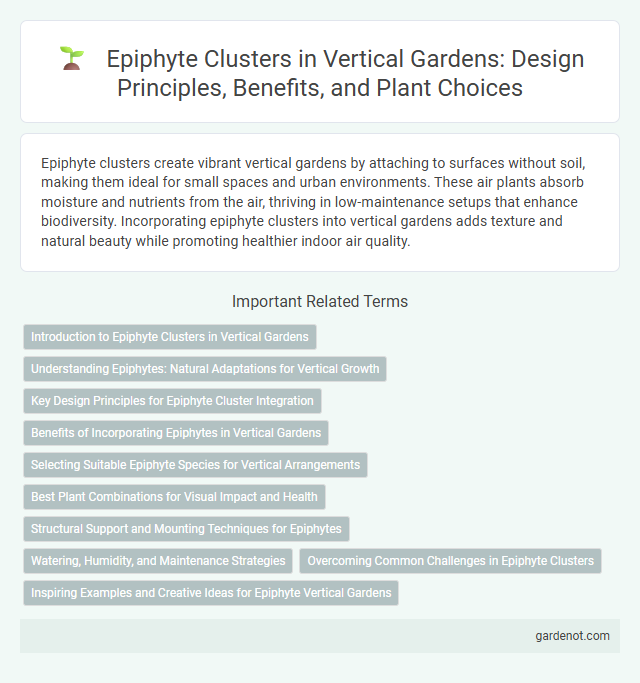Epiphyte clusters create vibrant vertical gardens by attaching to surfaces without soil, making them ideal for small spaces and urban environments. These air plants absorb moisture and nutrients from the air, thriving in low-maintenance setups that enhance biodiversity. Incorporating epiphyte clusters into vertical gardens adds texture and natural beauty while promoting healthier indoor air quality.
Introduction to Epiphyte Clusters in Vertical Gardens
Epiphyte clusters are essential components of vertical gardens, characterized by plants that grow on other surfaces without soil, deriving moisture and nutrients from the air and rain. These clusters create vibrant, low-maintenance green walls by combining species such as orchids, bromeliads, and ferns, which thrive in high humidity and indirect light conditions. Integrating epiphyte clusters enhances biodiversity, improves air quality, and adds depth and texture to vertical garden designs.
Understanding Epiphytes: Natural Adaptations for Vertical Growth
Epiphyte clusters thrive in vertical gardens by utilizing natural adaptations such as specialized root systems that anchor to surfaces without soil, enabling efficient nutrient and moisture absorption from the air and rain. These plants exhibit unique physiological traits like CAM photosynthesis to conserve water and tolerate varying light conditions, optimizing vertical growth. Understanding these adaptations enhances vertical garden design by promoting biodiversity and sustainable maintenance.
Key Design Principles for Epiphyte Cluster Integration
Epiphyte cluster integration in vertical gardens prioritizes air circulation and moisture retention to mimic natural habitats, ensuring optimal growth conditions for air plants. Design principles emphasize selecting lightweight, non-soil substrates like sphagnum moss or bark to support roots while preventing waterlogging. Strategic placement on vertical structures with varied light exposure fosters biodiversity and enhances aesthetic appeal through layered textures and colors.
Benefits of Incorporating Epiphytes in Vertical Gardens
Epiphyte clusters in vertical gardens enhance biodiversity by providing natural habitats for beneficial insects and birds, improving ecosystem balance. Their unique ability to absorb moisture and nutrients from the air reduces the need for frequent watering, promoting water conservation. Incorporating epiphytes also boosts air purification and indoor air quality, making vertical gardens healthier and more sustainable.
Selecting Suitable Epiphyte Species for Vertical Arrangements
Choosing suitable epiphyte species for vertical garden arrangements requires evaluating their air and moisture needs, growth habits, and compatibility with the available light conditions. Species such as Tillandsia, Spanish moss (Tillandsia usneoides), and certain orchids thrive in vertical setups due to their lightweight structures and minimal soil requirements. Ensuring that selected epiphytes have complementary humidity tolerance and attachment mechanisms promotes sustained growth and aesthetic appeal in vertical garden installations.
Best Plant Combinations for Visual Impact and Health
Epiphyte clusters thrive when combining orchids, bromeliads, and air plants, delivering vibrant textures and colors ideal for vertical gardens. These plants benefit from shared humidity and light conditions, enhancing overall health and resilience against pests. Mixing species with varying leaf shapes and bloom times maximizes visual impact while maintaining balanced microclimates.
Structural Support and Mounting Techniques for Epiphytes
Epiphyte clusters require specialized structural support systems, such as mesh frames or wooden slats, to mimic their natural attachment to trees while ensuring stability and airflow. Mounting techniques involve securing plants with biodegradable ties or fishing line to prevent damage and allow growth expansion. Proper orientation and spacing optimize light exposure and moisture retention, critical for the health of epiphytic plants in vertical gardens.
Watering, Humidity, and Maintenance Strategies
Epiphyte clusters thrive in vertical gardens by maintaining consistent moisture levels through misting and using humidity trays to simulate their natural environment. Watering strategies prioritize light, frequent hydration to prevent root rot while encouraging air circulation to reduce fungal growth. Regular inspection and pruning of dead leaves support healthy growth and prevent pest infestations in these moisture-sensitive plants.
Overcoming Common Challenges in Epiphyte Clusters
Epiphyte clusters often face challenges such as limited water retention and nutrient absorption due to their non-soil growing environment. Implementing efficient irrigation systems like misting or drip setups ensures consistent moisture levels, while using organic mulches or specialized substrates enhances nutrient availability. Selecting shade-tolerant epiphyte species and monitoring humidity can prevent desiccation and promote healthy growth within vertical garden installations.
Inspiring Examples and Creative Ideas for Epiphyte Vertical Gardens
Epiphyte clusters create dynamic vertical garden designs by leveraging plants like Tillandsia, Spanish moss, and orchids that thrive without soil. These installations use driftwood, wire frames, or mesh panels to mimic natural habitats, fostering moisture retention and air circulation essential for epiphyte health. Creativity flourishes with staggered arrangements and mixed species, transforming walls into living art that enhances indoor air quality and aesthetic appeal.
Epiphyte cluster Infographic

 gardenot.com
gardenot.com